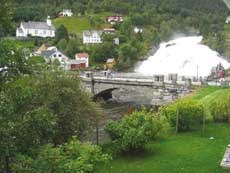Local commitment crucial for future of Norwegian fjord country
Historical archive
Published under: Stoltenberg's 2nd Government
Publisher: Ministry of the Environment
Press release | Date: 10/06/2006 | Last updated: 11/11/2006
The fjord country of western Norway is one of the world's most beautiful landscapes. Its inclusion on the Unesco World Heritage List, while most certainly warranted, carries with it obligations affecting all who are responsible for managing the region, says environment minister Helen Bjørnøy.
Press Release
Dato: 2006.10.06
Minister of Environment Helen Bjørnøy:
- Local commitment crucial for future of Norwegian fjord country
The fjord country of western Norway is one of the world's most beautiful landscapes. Its inclusion on the Unesco World Heritage List, while most certainly warranted, carries with it obligations affecting all who are responsible for managing the region, says environment minister Helen Bjørnøy.
The fjord country of western Norway is one of the world's most beautiful landscapes. Its inclusion on the Unesco World Heritage List, while most certainly warranted, carries with it obligations affecting all who are responsible for managing the region, says environment minister Helen Bjørnøy.
The Ministry of Environment has scheduled two major events to mark the achievement of Geiranger- and Nærøyfjord and the surrounding countryside in gaining entry to the Unesco World Heritage List. H.M. Queen Sonja is taking part in both events, in Flåm on 10 June and in Geiranger on 12 June.
- Local involvement and determination to manage the region in a sustainable manner will be crucial to the future of the region, says environment minister Helen Bjørnøy. The establishment of a World Heritage site in the fjord country of western Norway lays the groundwork for a fruitful collaboration between local and central government authorities. Norway has committed itself to looking after this region, as common heritage for the earth's population, says Bjørnøy.
 The region was inscribed on the list, on 14 July 2005, for its unique qualities as a natural environment. This is Norway's first natural heritage site on the list. It joins six others, all cultural heritage sites: Bryggen in Bergen, Urnes stave church, Røros, the rock drawings of Alta, the Vega archipelago and the Struve Geodetic Arc. There are 812 World Heritage sites altogether.
The region was inscribed on the list, on 14 July 2005, for its unique qualities as a natural environment. This is Norway's first natural heritage site on the list. It joins six others, all cultural heritage sites: Bryggen in Bergen, Urnes stave church, Røros, the rock drawings of Alta, the Vega archipelago and the Struve Geodetic Arc. There are 812 World Heritage sites altogether.
The citation from Unesco states that the Nærøyfjord and Geirangerfjord regions are among the most beautiful fjord landscapes on the globe. The climate, the river systems and the waterfalls have formed the basis of a rich, distinctive and diverse flora and fauna.
Characteristic natural features include the narrow confined valleys with precipitous slopes stretching from 500 metres underwater to 1400m heights over the Norwegian sea. There are countless waterfalls and rivers which run from jagged mountains, glaciers and glacial lakes through deciduous and coniferous forests and down to the fjord.
In addition to a great range of supporting natural phenomena, the cultural environment reinforces the impact of the region. Abandoned farms and mountain pastures add a cultural aspect to the dramatic natural landscape that complements and adds human interest to the area, according to the World Heritage committee.
The West Norwegian Fjords World Heritage site comprises two areas:
Geirangerfjord, including Stranda and Norddal municipalities in Møre og Romsdal county; Nærøyfjorden, covering Aurland, Vik and Lærdal municipalities in Sogn og Fjordane county, and Voss municipality in Hordaland.
Read more about World Heritage and Norway
Presscontact: Ingun Larsen, tel +47 92 60 77 42